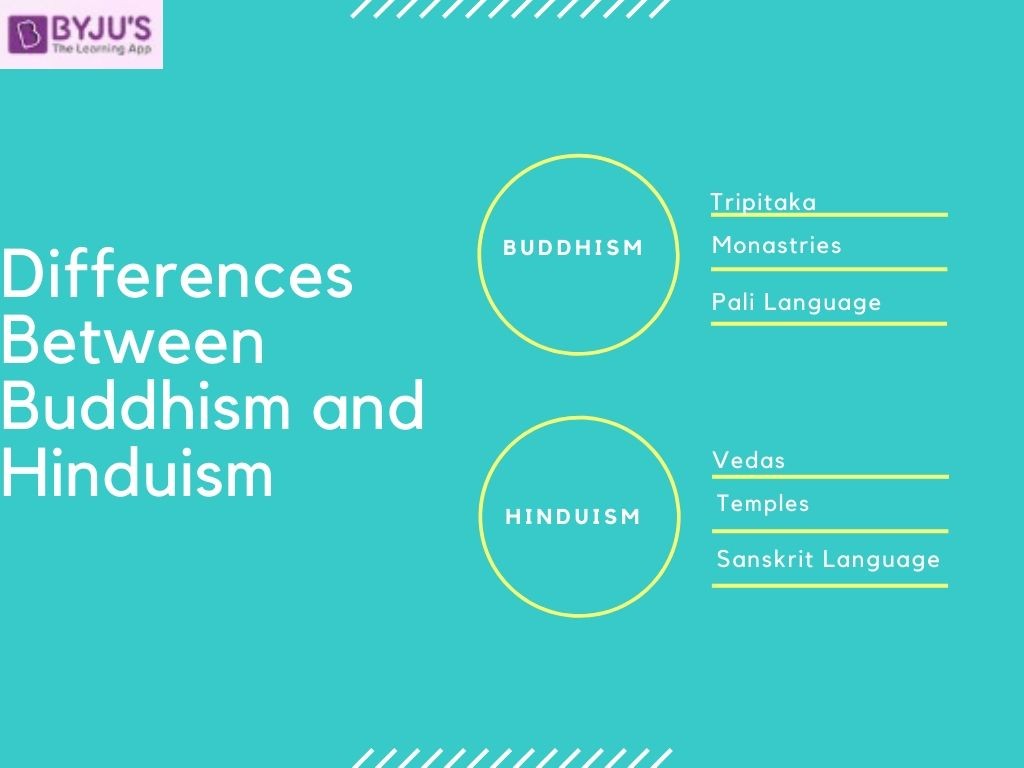Hinduism and Buddhism, two of the world’s major religions, originated in the Indian subcontinent and share some common threads, yet they possess distinct beliefs, practices, and philosophies. Understanding the nuances between them is crucial for anyone seeking to grasp the rich tapestry of Eastern spirituality. Often referred to as the oldest religion, Hinduism, or “the eternal way,” boasts a vast history and diverse traditions. Buddhism, emerging later from the teachings of Siddhartha Gautama (the Buddha), offers a path to enlightenment centered on personal awakening and the cessation of suffering. This article delves into a detailed comparison of Hinduism and Buddhism, highlighting their key differences and illuminating their shared principles.
 Comparison of Buddhism and Hinduism
Comparison of Buddhism and Hinduism
Key Differences Between Hinduism and Buddhism
While both religions originated in India and share cultural context, their doctrinal and practical differences are significant. The following table provides a detailed comparison across various aspects:
| Feature | Buddhism | Hinduism |
|---|---|---|
| Followers | Buddhists | Hindus |
| Global Presence | World’s fourth largest religion, approximately 520 million followers (around 7% of global population). Strong presence in Asian countries. | World’s third largest religion, approximately 1.25 billion followers (around 16% of global population). Predominantly in India, Nepal, and other regions with Indian diaspora. |
| Places of Worship | Buddhist monasteries, shrines, stupas, temples, pagodas. | Hindu temples (Mandirs). |
| Founder | Siddhartha Gautama (the Buddha), who is considered the enlightened teacher and sage, not a god. | No single founder. Evolved organically from Vedic traditions and diverse Indian philosophies over millennia. |
| Spiritual Leadership | In Tibetan Buddhism, the Dalai Lama is the foremost spiritual leader. However, Buddhism generally emphasizes individual spiritual practice and guidance from monastic communities. | No single, overarching spiritual leader. Diverse traditions and lineages with gurus, swamis, and religious scholars providing guidance. |
| Monastic Communities | Highly structured monastic communities (Sangha) of Bhikkhus (male monks) and Bhikkhunis (female monks) are central to preserving and propagating Buddhist teachings. | Monastic traditions exist (Sannyasis/Sadhvis), but Hinduism is more diverse, with a strong emphasis on householder life and various paths to spiritual realization. Gurus and priests play important roles but are not centrally organized. |
| Major Branches/Denominations | Two major branches: Theravada (School of the Elders) and Mahayana (Great Vehicle). Vajrayana (Diamond Vehicle) is also a significant tradition, particularly in Tibetan Buddhism. | Four major denominations: Vaishnavism (worship of Vishnu), Shaivism (worship of Shiva), Shaktism (worship of Shakti/Devi), and Smartism (worship of multiple deities as aspects of Brahman). Numerous other sects and traditions exist. |
| Sacred Languages | Pali (primary for Theravada), Sanskrit (primary for Mahayana and Vajrayana). | Sanskrit is the primary sacred language. Many regional languages also hold religious significance. |
| Key Festivals | Vesak (Buddha’s Birthday), Parinirvana Day, Buddha Purnima, Ullambana (Ghost Festival), Losar (Tibetan New Year), various local festivals. | Numerous festivals throughout the year dedicated to different deities and events, including Diwali, Holi, Navaratri, Durga Puja, Ganesh Chaturthi, Mahashivaratri, Ram Navami, Krishna Janmashtami, and many more. |
| Primary Scriptures | Tripitaka (Pali Canon) – consisting of Vinaya Pitaka (monastic discipline), Sutta Pitaka (discourses), and Abhidhamma Pitaka (philosophical analysis). Mahayana Sutras (e.g., Lotus Sutra, Heart Sutra). | Vedas (Rigveda, Samaveda, Yajurveda, Atharvaveda), Upanishads, Puranas, Mahabharata (including Bhagavad Gita), Ramayana, Agamas, and numerous other texts. No single canonical scripture. |
| Important Symbols | Dharmachakra (Wheel of Dharma), Lotus, Conch Shell, Endless Knot, Pair of Fish, Victory Banner, Parasol, Stupa. | Om (Aum), Swastika, Sri Yantra, Trishul (Trident), Lingam, Nataraja, various deity-specific symbols. |
| Marriage | Marriage is a secular affair, not a religious duty. Monastic members practice celibacy. Guidance offered for harmonious married life, but not considered essential for spiritual progress. | Marriage is a significant social and religious duty (Dharma). One of the four Ashramas (stages of life) is Grihasthashrama (householder stage). Emphasis on family and lineage. |
| Concept of Sin | Does not have a concept of sin in the Abrahamic sense. Focuses on actions that cause suffering (karma) and their consequences. Emphasis on understanding and overcoming negative mental states. | Concept of Papa (sin) exists. Actions have Karmic consequences. Repentance and expiation are possible for unintentional sins. Deliberate wrongdoing leads to negative karmic repercussions. |
| Origins | Originated with Siddhartha Gautama in the 6th century BCE in Bodh Gaya, India. First sermon in Sarnath. | Origins are traced back to ancient Vedic traditions in the Indian subcontinent, possibly before 3000 BCE. Evolved over centuries through a synthesis of various beliefs and practices. |
| Authority of Vedas | Rejected the authority of the Vedas. Buddha’s teachings offered an alternative path to liberation. | Vedas are considered supreme revealed scriptures (Shruti), foundational to Hindu philosophy and practice. |
| Ultimate Goal | Nirvana (liberation from suffering and the cycle of rebirth). Attainment of lasting, unconditional happiness and enlightenment. | Moksha (liberation from the cycle of birth and rebirth). Union with Brahman (ultimate reality). Different schools emphasize various paths to Moksha (e.g., Karma Yoga, Bhakti Yoga, Jnana Yoga). |
| Geographical Distribution | Historically spread throughout Asia. Currently prevalent in countries like Sri Lanka, Thailand, Myanmar, Cambodia, Vietnam, Laos, Bhutan, Japan, Korea, China, and regions within India and Nepal. Growing presence in the West. | Primarily concentrated in India, Nepal, and Bhutan. Significant Hindu diaspora populations in Mauritius, Caribbean, North America, Bali (Indonesia), and other parts of the world. |
| Path to Enlightenment | Noble Eightfold Path: Right Understanding, Right Thought, Right Speech, Right Action, Right Livelihood, Right Effort, Right Mindfulness, Right Concentration. | Multiple paths (Yogas) to enlightenment: Karma Yoga (path of action), Bhakti Yoga (path of devotion), Jnana Yoga (path of knowledge). Emphasis on Dharma (righteous conduct), Artha (material prosperity), Kama (pleasure), and Moksha (liberation) as Purusharthas (aims of human life). |
| Concept of God | Non-theistic or trans-theistic. Does not emphasize a creator God. Focuses on self-effort, personal awakening, and the potential for Buddhahood within all beings. | Theistic. Belief in a Supreme Being or ultimate reality (Brahman) which manifests in various forms as gods and goddesses. Worship of deities is central to many Hindu traditions. |
| Social Structure | Rejected the rigid caste system prevalent in ancient India. Emphasized spiritual equality and accessibility of enlightenment for all regardless of social background. Monastic Sangha offered an alternative social structure. | Historically associated with the Varna (caste) system, although its rigidity and implications are debated and challenged within Hinduism. Emphasis on Dharma specific to one’s Varna and Ashrama. |
| Soul/Self | Anatman (no-self). Rejects the concept of a permanent, unchanging soul (Atman) as understood in Hinduism. Focuses on impermanence and the interconnectedness of all phenomena. | Atman (soul/self) is considered eternal, unchanging, and part of Brahman. The goal is to realize the true nature of Atman and its unity with Brahman. |
| Reincarnation/Rebirth | Believes in rebirth (reincarnation) driven by karma. The cycle of rebirth continues until Nirvana is attained. | Believes in reincarnation (Samsara). The soul (Atman) transmigrates through lifetimes based on karma until Moksha is achieved. |
Key Similarities Between Hinduism and Buddhism
Despite their distinct differences, Hinduism and Buddhism share several important similarities, rooted in their common Indian origin and spiritual heritage:
- Shared Philosophical Concepts: Both religions share concepts like Karma (action and consequence), Dharma (righteous conduct/universal law), Samsara (cycle of birth, death, and rebirth), and Moksha/Nirvana (liberation from suffering and the cycle of rebirth), although their interpretations may differ.
- Meditation and Yoga: Both traditions emphasize meditation and yoga as paths to spiritual development and self-realization. Various meditation techniques and yogic practices are found in both Hinduism and Buddhism.
- Respect for all Life: Both religions advocate for non-violence (Ahimsa) and respect for all living beings. Compassion and empathy are central virtues in both traditions.
- Cyclical Time: Both religions view time as cyclical rather than linear, with cosmic cycles of creation, preservation, and destruction.
- Rejection of Materialism: Both traditions, in their core philosophies, caution against excessive attachment to material possessions and worldly desires as hindrances to spiritual progress.
- Idol Worship (in some branches): While Theravada Buddhism traditionally does not focus on idol worship, Mahayana Buddhism incorporates the veneration of Buddhas and Bodhisattvas in image form, similar to the Murtis (idols) in Hinduism.
- Ethical Conduct: Both religions place a strong emphasis on ethical conduct, moral principles, and virtuous living as essential for spiritual growth.
- Indian Origins: Both religions originated in the Indian subcontinent and have shaped and been shaped by Indian culture and philosophy.
Conclusion
Comparing and contrasting Hinduism and Buddhism reveals two distinct yet intertwined spiritual paths. While Hinduism, with its ancient roots and diverse pantheon, offers a broad spectrum of devotional and philosophical approaches, Buddhism, founded on the Buddha’s enlightenment, provides a focused path to liberation through self-awareness and ethical conduct. Understanding their differences clarifies their unique identities, while recognizing their similarities highlights their shared Indian spiritual heritage and enduring quest for ultimate truth and liberation from suffering. Both traditions continue to offer profound wisdom and guidance to millions seeking meaning and purpose in life.

